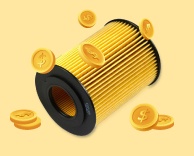Achieve Perfect Lubrication: 4 Essential Steps for Cost Savings & Energy Efficiency
Introduction
Oil lubrication is one of the most vital components in machinery maintenance. Its primary
function is to create a protective layer between moving parts to reduce friction, which helps in
preventing excessive wear and tear. Proper lubrication not only enhances machine longevity but
also boosts operational efficiency by reducing energy consumption.
However, the challenge lies in achieving the right balance between not enough and too much
lubrication. Poor lubrication practices can result in inefficiencies and premature equipment
failure. In this article, we will explore four essential steps you can take to optimize your
lubrication process, leading to cost savings, energy efficiency, and better overall machinery
performance.
The Importance of Proper Lubrication
Lubrication forms the foundation of smooth and efficient machine operation. Machines with high
friction between parts wear out faster, consume more energy, and experience more frequent
breakdowns. Proper lubrication:
- Reduces friction: Lubricant forms a thin layer between moving parts, which prevents them from directly rubbing against each other, thereby reducing friction.
- Prevents overheating: Friction generates heat, which can cause overheating in machines. Lubrication helps to dissipate this heat and maintain an optimal operating temperature.
- Extends machine life: Consistent lubrication prevents excessive wear and tear, which in turn extends the life of machinery components, reducing the frequency of repairs.
- Improves energy efficiency: When friction is minimized, machinery doesn’t need to work as hard, leading to reduced energy consumption.
However, improper lubrication can lead to detrimental effects, including energy inefficiency, overheating, and equipment failure. This is why it is crucial to understand how to optimize the lubrication process.
Common Lubrication Mistakes to Avoid
While the importance of lubrication is well understood, many companies still make critical mistakes in their lubrication practices. Here are the most common ones:
- Over-lubrication: Applying too much lubricant does not necessarily improve performance. It can cause problems such as increased friction, excess waste, and even contamination of the machinery. Over-lubrication can also increase energy consumption because the extra lubricant acts as an insulating layer that makes it harder for heat to dissipate.
- Under-lubrication: On the other hand, under-lubrication is equally damaging. Without enough lubricant, friction increases, leading to higher wear rates, more frequent breakdowns, and reduced machine lifespan.
- The wrong type of lubricant: Not all lubricants are created equal. The wrong type of oil or grease can fail to protect your machinery effectively. For example, some lubricants may not function well in extreme temperatures, while others may break down too quickly under pressure.
- Irregular lubrication schedule: If you don’t lubricate your machines at the right intervals, you might waste lubricant or fail to prevent friction and wear. It’s important to schedule lubrication based on factors such as machine usage, environmental conditions, and the speed of operation.
These mistakes can cost a company significantly in terms of downtime, repairs, and energy costs. To avoid these, it's crucial to follow a structured lubrication routine and closely monitor the lubrication process.
Step 1: Calculate the Correct Lubrication Schedule
The first step toward achieving perfect oil lubrication is to create a tailored lubrication schedule for each piece of machinery. Many companies simply use the same lubrication intervals for all machines, but this can lead to either over-lubrication or under-lubrication. The key is to calculate the lubrication frequency based on the machine's operational conditions and type.
Factors to consider when determining lubrication schedules:
- Machine Speed: Slow-moving machines may require more frequent lubrication since they don’t generate enough movement to evenly distribute the lubricant across parts. Fast-moving machines, on the other hand, often require less frequent lubrication because the movement itself helps circulate the oil.
- Operating Environment: Machines operating in harsh environments with high temperatures or exposure to contaminants may need lubrication more often. Machines in clean and controlled environments can be lubricated less frequently.
- Load and Pressure: Machines that operate under heavy loads or high pressure require more frequent lubrication to minimize friction and wear.
- Temperature: Machines operating in hot or cold environments may need specific types of lubricants that can withstand those conditions. Proper scheduling ensures the right amount of lubricant is applied.
By carefully considering these factors, companies can calculate the optimal lubrication intervals, ensuring machines are properly maintained without overusing resources.
Step 2: Daily Pre-Trip Check by Machinery Operators
In addition to regular lubrication schedules, operators should conduct a pre-trip inspection
every day before starting the machinery. This proactive measure helps identify early signs of
lubrication issues and prevents costly problems from developing.
Daily pre-trip checks include:
- Viscosity check: Lubricants should be of the right thickness viscosity to provide effective friction reduction. If the lubricant has thinned out due to excessive heat, it may need to be replaced.
- Color check: Discoloration or cloudiness of the lubricant may indicate contamination. If oil turns milky or dark, it could be a sign of water or dirt entering the system.
- Level check: Operators should check if the lubricant level is within the specified range. Low oil levels can result in insufficient lubrication while overfilling can lead to leakage and waste.
By incorporating daily pre-trip checks, operators can detect contamination or any lubrication deficiencies before they affect machine performance.
Step 3: Regular Cleaning of Lubricant Sumps
Lubricant sumps are designed to hold the lubricant and provide a reservoir for oil circulation. However, over time, these sumps can accumulate contaminants like dirt, metal particles, and sludge. If the sump is not cleaned regularly, the contaminants will degrade the lubricant and reduce its effectiveness.
Cleaning the lubricant sump should become a part of routine maintenance. Regular cleaning will:
- Extend the life of the oil: By removing contaminants, the oil can continue to perform at optimal levels for longer.
- Prevent varnish and sludge formation: These byproducts can clog filters, damage equipment, and lead to machine inefficiencies.
- Reduce the frequency of oil changes: With proper sump maintenance, the oil will stay cleaner for longer, reducing the need for frequent replacements.
Step 4: Monitoring Key Lubrication Properties
It’s important to monitor several key properties of the lubricant to ensure it remains effective:
- Viscosity: The oil should maintain a certain viscosity level to reduce friction and provide adequate protection. Low-viscosity oils tend to break down more quickly, while oils that are too thick can cause excessive friction.
- Grease Consistency: The consistency of grease should be stable enough to remain in place and lubricate the moving parts effectively. A grease that’s too runny will leak out, while grease that’s too stiff may not flow properly.
- Oil Volume: Having the right amount of lubricant is crucial. Too much oil can lead to wastage and increased energy consumption, while too little can lead to overheating and excessive wear.
- Filtration: Ensuring that the oil is free from contaminants is key to maintaining the quality of the lubricant. A good filtration system helps keep the oil clean and effective for longer periods.
Regularly monitoring these properties ensures that the oil remains effective in reducing friction, protecting the machine, and minimizing wear.
Conclusion
Perfect oil lubrication is not a one-size-fits-all approach. It requires careful consideration of the machine’s operational needs, environment, and the type of lubricant being used. By following the four essential steps outlined in this article calculating the right lubrication schedule, conducting daily checks, cleaning sumps, and monitoring lubricant properties companies can significantly reduce maintenance costs, save energy, and enhance the performance and longevity of their machinery.





